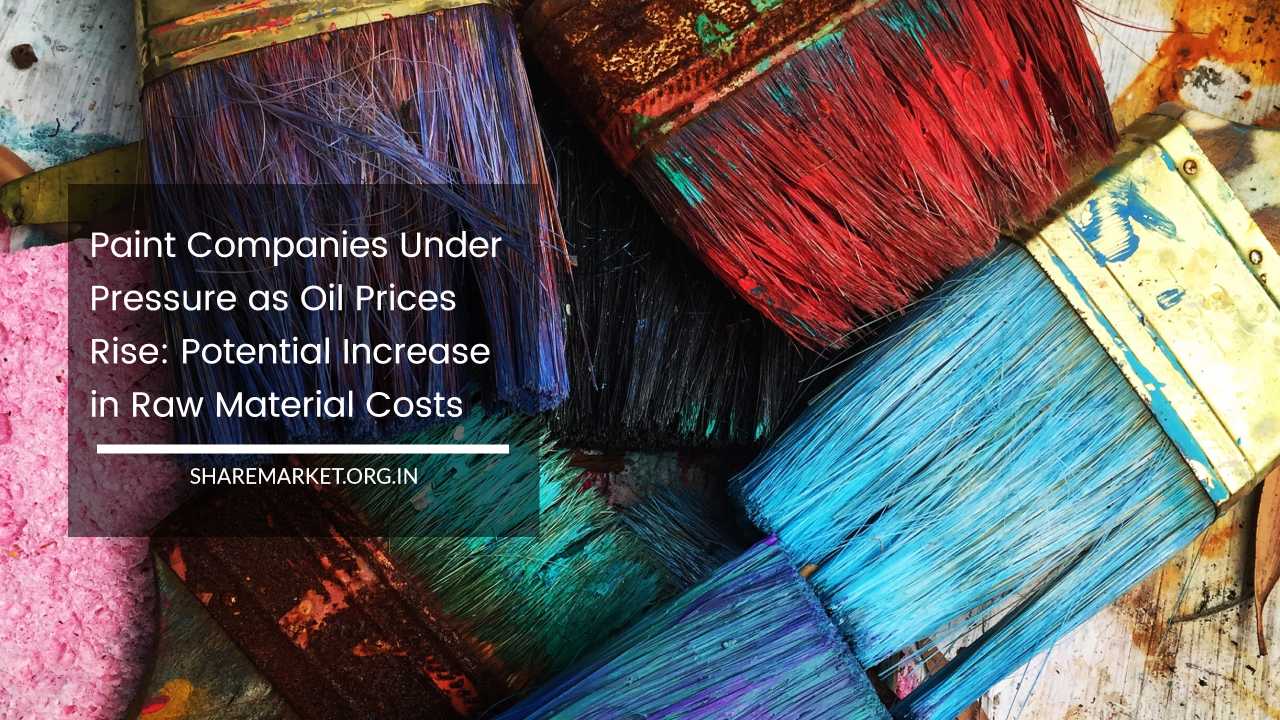Paint Companies Under Pressure as Oil Prices Rise: Potential Increase in Raw Material Costs

Oil Prices Rise
The recent surge in oil prices is anticipated to have a significant impact on paint companies as it is expected to lead to an increase in the cost of raw materials.
The rise in oil prices comes in the backdrop of market expectations of a supply crunch and a pause in rate hikes by the US Federal Reserve, which has contributed to the upward momentum in crude oil prices.
Over the past period, crude oil prices have been steadily climbing, with Brent crude oil reaching a notable three-month high of $81.57 per barrel in the previous session.
This upward trajectory has prompted concerns about potential supply shortages, primarily linked to ongoing issues in oil-producing countries like Libya and Nigeria.
For paint companies, crude oil and its derivatives form a significant portion of their raw materials. As oil prices increase, so does the cost of producing key inputs for paint manufacturing, such as solvents, resins, and additives.
Consequently, this is likely to exert pressure on paint companies, as they grapple with higher production costs, which may impact their profit margins.
Furthermore, the rise in oil prices can lead to inflationary pressures in the broader economy, which may also affect consumer spending patterns and demand for paint products.
Paint companies may face challenges in managing these cost escalations while remaining competitive in the market.
In conclusion, the increasing oil prices and the resulting rise in raw material costs pose significant challenges for paint companies.
As the situation evolves, these companies may need to closely monitor market dynamics, explore cost-saving measures, and possibly adjust their pricing strategies to navigate through this period of heightened uncertainty.
July Sees an 8% Surge in Oil Prices
In July, oil prices have experienced a significant uptick, surging by 8 percent. Several factors have contributed to this notable increase in oil prices, generating a positive sentiment in the market.
One of the key contributing factors is the anticipation that the US Federal Reserve may conclude its rate hike campaign. The possibility of a pause or halt in interest rate hikes has added to the market’s optimism, as it can have a stabilizing effect on the global economy and stimulate demand for commodities like oil.
Furthermore, a weakening US dollar has played a role in bolstering oil prices. As the US dollar depreciates, commodities priced in dollars, such as oil, become more affordable for buyers using other currencies, potentially leading to increased demand and subsequent price appreciation.
The decisions of major oil-exporting countries, Saudi Arabia and Russia, have also impacted oil prices. Starting from November of the previous year, both nations decided to curtail their oil production. This move aimed at reducing the global oil supply, thus creating a supportive environment for higher oil prices.
As a result of these multiple factors coming into play, the prices of Brent crude oil have surged by 8 percent during the month of July.
This considerable increase has been met with market interest and speculation as investors closely monitor the evolving dynamics of the oil market.
While higher oil prices can benefit oil-producing nations and industries, they can also pose challenges for oil-importing countries and businesses that rely heavily on oil-based products.
As the oil market continues to respond to changing geopolitical and economic factors, fluctuations in oil prices are expected to remain a significant point of focus for investors, policymakers, and businesses alike.
Crucial Reliance: Paint Production Hinges on Crude-Based Derivatives
The paint manufacturing industry heavily relies on crude oil derivatives as crucial raw materials for its production processes.
These derivatives play a significant role in the formulation of paints, making the cost of manufacturing directly susceptible to fluctuations in crude oil prices.
As crude oil prices rise or fall, the cost of these derivatives correspondingly increases or decreases, consequently impacting the overall manufacturing expenses for paint companies.
Crude oil derivatives find extensive use in various aspects of paint production, such as solvents, resins, pigments, and additives.
These components are essential for achieving the desired properties and characteristics in different types of paints, including water-based paints, oil-based paints, and specialty coatings.
Due to their indispensable role in the paint manufacturing process, any variations in the prices of these derivatives significantly influence the total production cost of paint companies.
Analysts estimate that approximately 40 percent of the total raw materials used by paint companies are derived from crude oil.
This substantial dependency underscores the sector’s vulnerability to changes in the oil market and highlights the critical need for paint manufacturers to closely monitor and manage their raw material costs.
The volatility of crude oil prices can lead to pricing challenges for paint companies, which may find it necessary to adjust the prices of their paint products in response to the cost fluctuations.
In a market environment where competitive pricing is crucial, such cost variations can pose a strategic dilemma for paint companies, requiring them to strike a balance between managing margins and remaining competitive in the market.
Moreover, supply chain disruptions, geopolitical events, and global economic factors can further complicate the situation, potentially creating uncertainties in the availability and pricing of crude oil derivatives for paint manufacturers.
Crude Oil Prices Exerting Pressure on Paint Companies
The relationship between crude oil prices and paint companies plays a crucial role in shaping their financial performance and profit margins.
When crude oil prices surge, it directly impacts the input cost for paint manufacturers, leading to increased production expenses.
This, in turn, puts significant pressure on their profit margins, as they face challenges in maintaining competitive pricing while dealing with higher raw material costs.
As a major raw material for decorative paint, the cost of crude oil derivatives directly influences the overall manufacturing cost for paint companies.
Decorative paints, which encompass a wide range of products like interior and exterior wall paints, enamels, and varnishes, heavily rely on these derivatives for their formulation.
Most brokerages are currently anticipating a potential recovery in paint companies’ profit margins during the April-June quarter.
This optimism stems from expectations of a reduction in input costs, which can be attributed to the moderation in crude oil prices during that period. A decline in raw material expenses could allow paint companies to enhance their profitability in the short term.
However, it is crucial to highlight that this expected margin recovery could face a potential reversal if oil prices continue to climb in the subsequent quarters.
A sustained increase in crude oil prices would lead to higher input costs once again, eroding the anticipated gains in profit margins for paint manufacturers.
Given the inherent sensitivity of the paint industry to crude oil prices, companies need to adopt prudent strategies to manage their raw material expenses effectively.
Proactive measures, such as hedging against price fluctuations or exploring alternative raw materials, can aid paint companies in stabilizing their production costs and protecting profit margins from excessive volatility in the oil market.
In conclusion, the interdependence between crude oil prices and the cost of raw materials for paint companies underscores the impact of oil price fluctuations on their financial performance.
While current expectations of margin recovery are based on reduced input costs, the ongoing trajectory of oil prices remains a critical factor that could influence the industry’s profitability in the long run.
As such, paint companies must closely monitor oil price trends and devise flexible strategies to navigate through the dynamic market conditions to maintain sustainable growth and competitiveness.

















